Why you can trust Tom's Hardware
Comparison Products
The Acer Predator GM7 is up against the WD Black SN850X, the Crucial P5 Plus, the SK hynix Gold P31, the Acer Predator GM3500, the Samsung 980 Pro, the Solidigm P44 Pro, and the Kingston Fury Renegade.
Trace Testing - 3DMark Storage Benchmark
Built for gamers, 3DMark’s Storage Benchmark focuses on real-world gaming performance. Each round in this benchmark stresses storage based on gaming activities including loading games, saving progress, installing game files, and recording gameplay video streams.
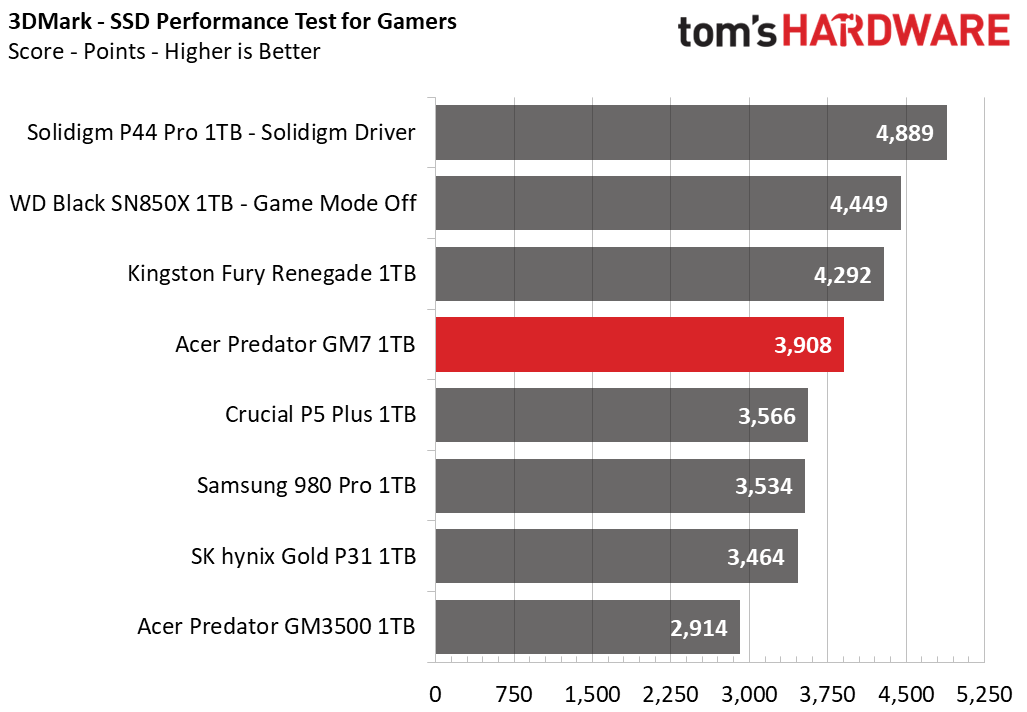
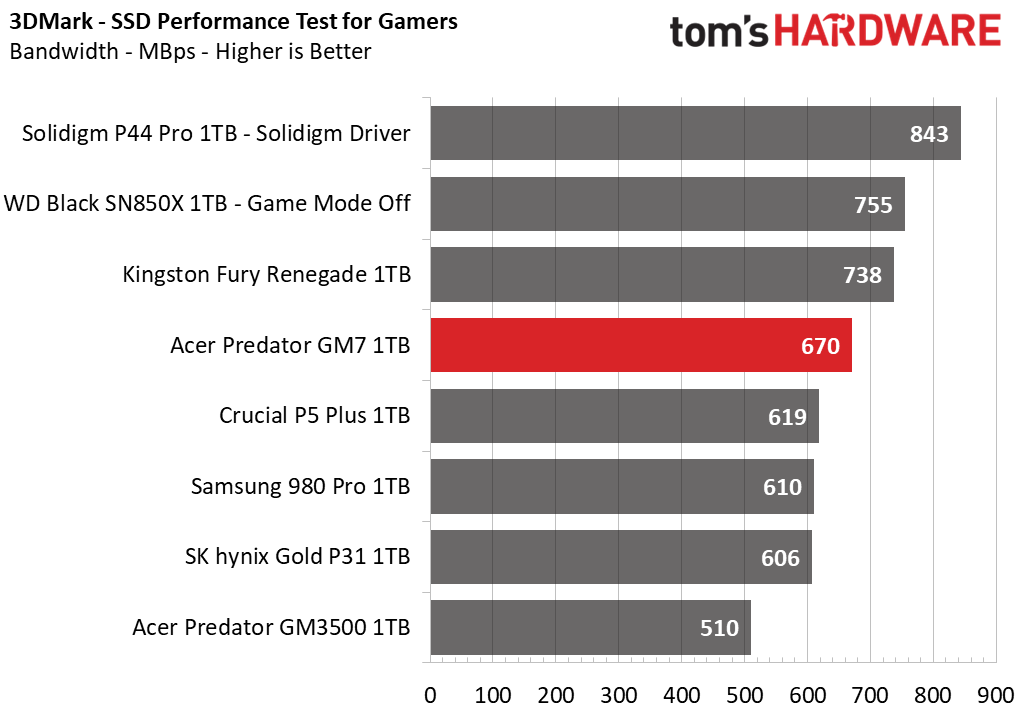
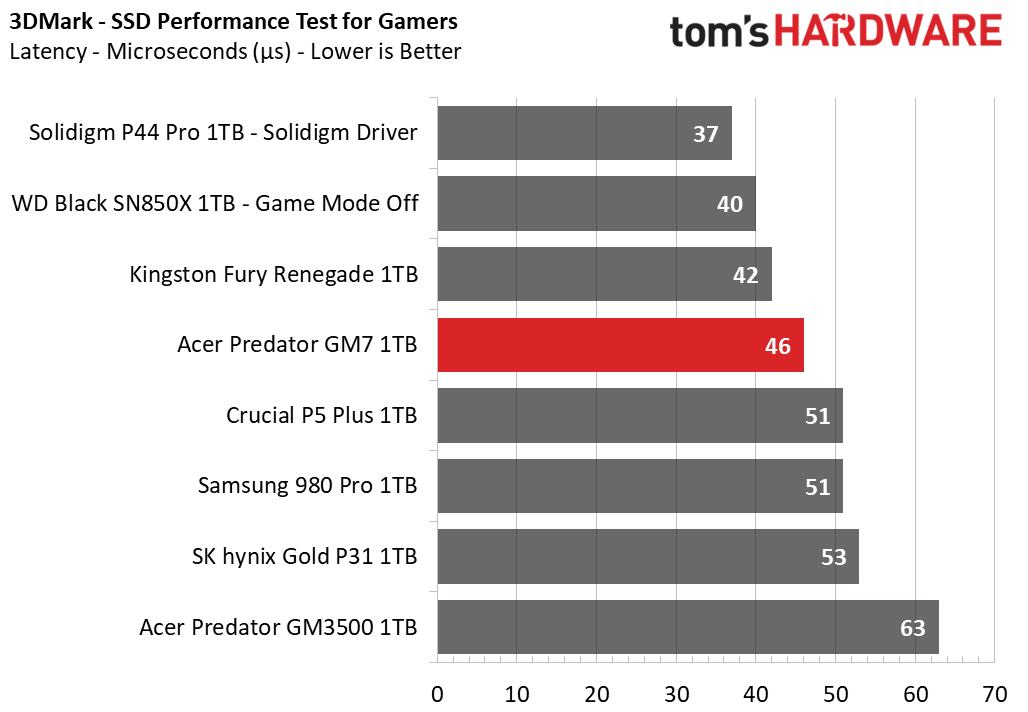
The Predator GM7 scores average to above-average scores in 3DMark. This is about where we would expect it to fall given its hardware — above PCIe 3.0 and older PCIe 4.0 drives, but below newer PCIe 4.0 options.
Trace Testing – PCMark 10 Storage Benchmark
PCMark 10 is a trace-based benchmark that uses a wide-ranging set of real-world traces from popular applications and everyday tasks to measure the performance of storage devices.


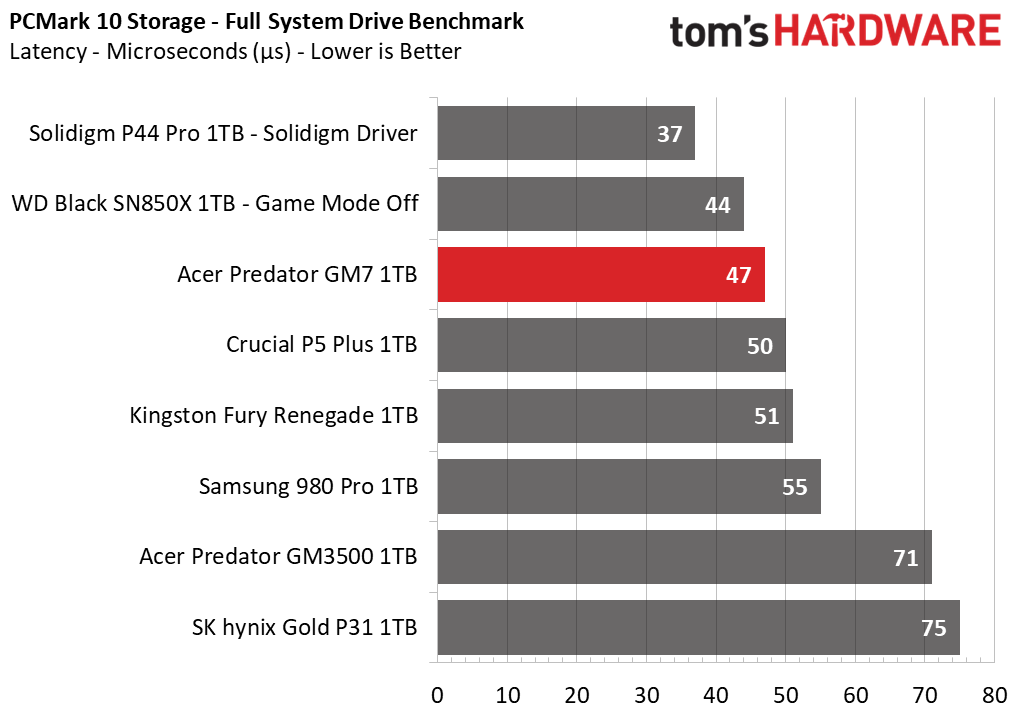
The Predator GM7 does a bit better in PCMark 10, managing to beat the Fury Renegade. The GM7’s fast bus helps it keep up and deliver a solid user experience.
Transfer Rates – DiskBench
We use the DiskBench storage benchmarking tool to test file transfer performance with a custom, 50GB dataset. We copy 31,227 files of various types, such as pictures, PDFs, and videos to a new folder and then follow-up with a reading test of a newly-written 6.5GB zip file.
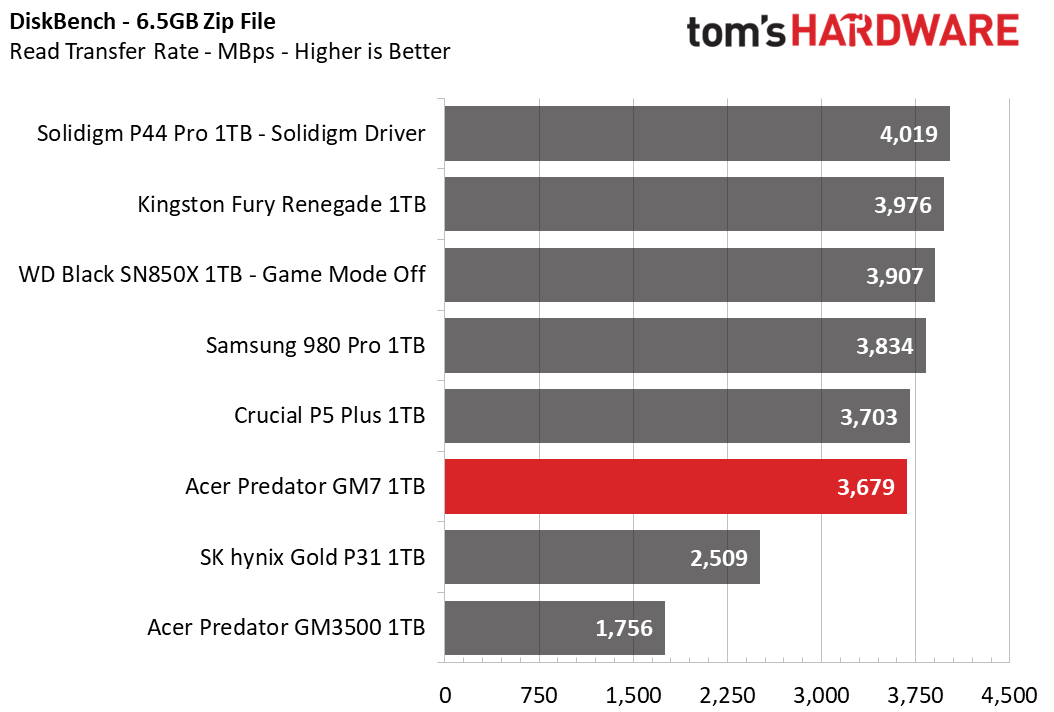
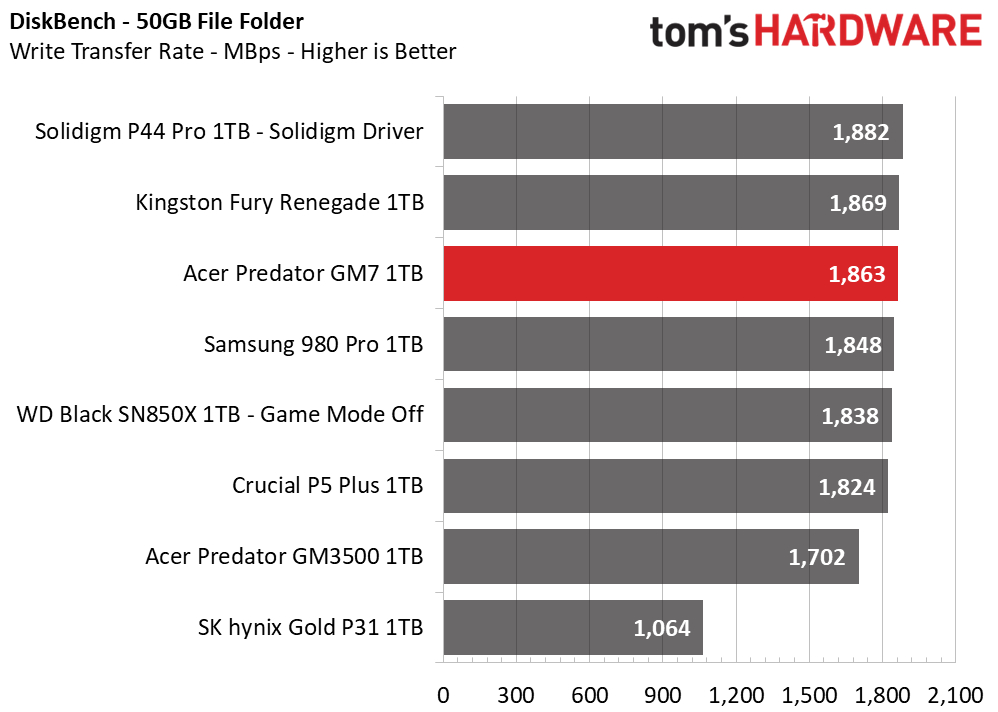

The fast bus also helps here, with file transfers, but the Predator GM7 can’t quite keep up with newer drives like the SN850X or P44 Pro or with the Fury Renegade’s newer flash. It’s possible that with 232-Layer TLC the Predator GM7 would perform a bit better.
Get Tom's Hardware's best news and in-depth reviews, straight to your inbox.
Synthetic Testing - ATTO / CrystalDiskMark
ATTO and CrystalDiskMark (CDM) are free and easy-to-use storage benchmarking tools that SSD vendors commonly use to assign performance specifications to their products. Both of these tools give us insight into how each device handles different file sizes.



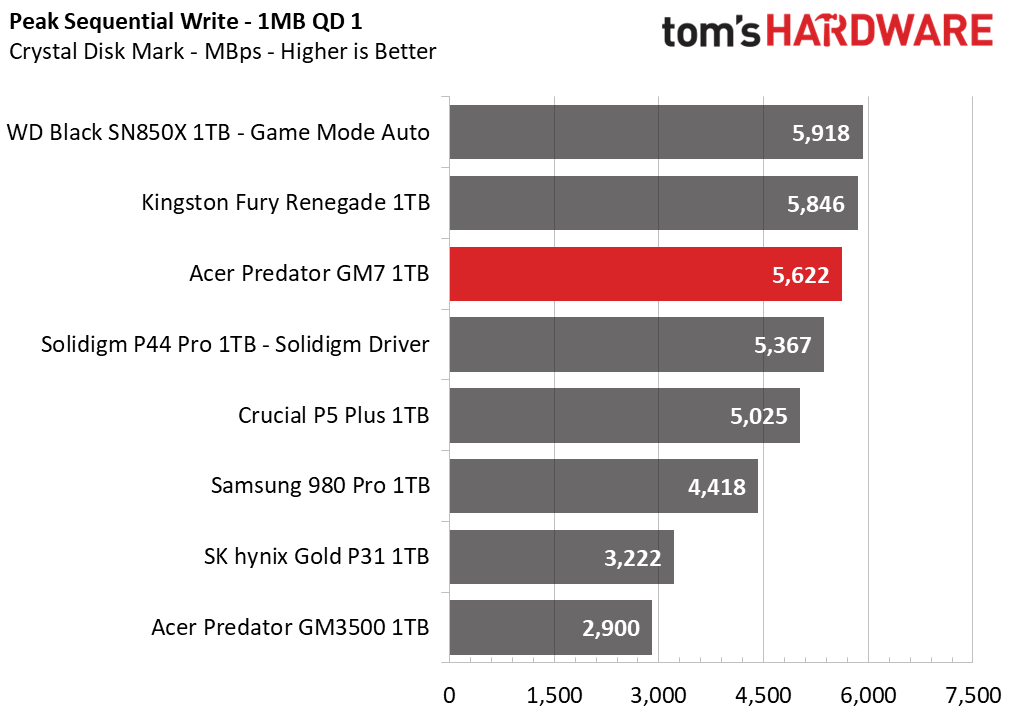
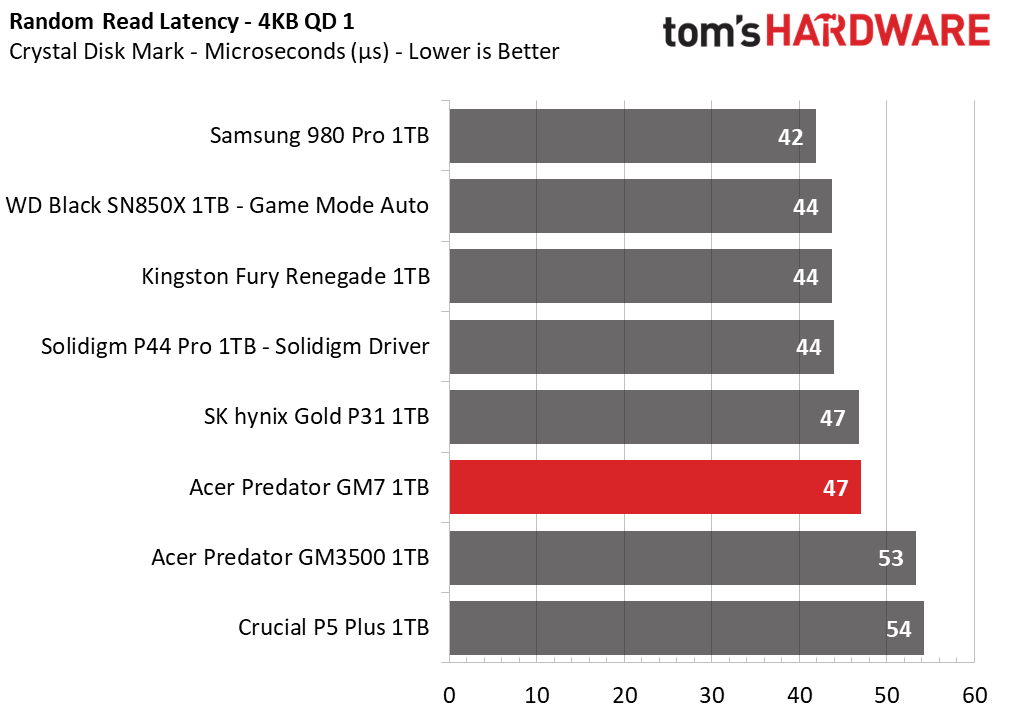
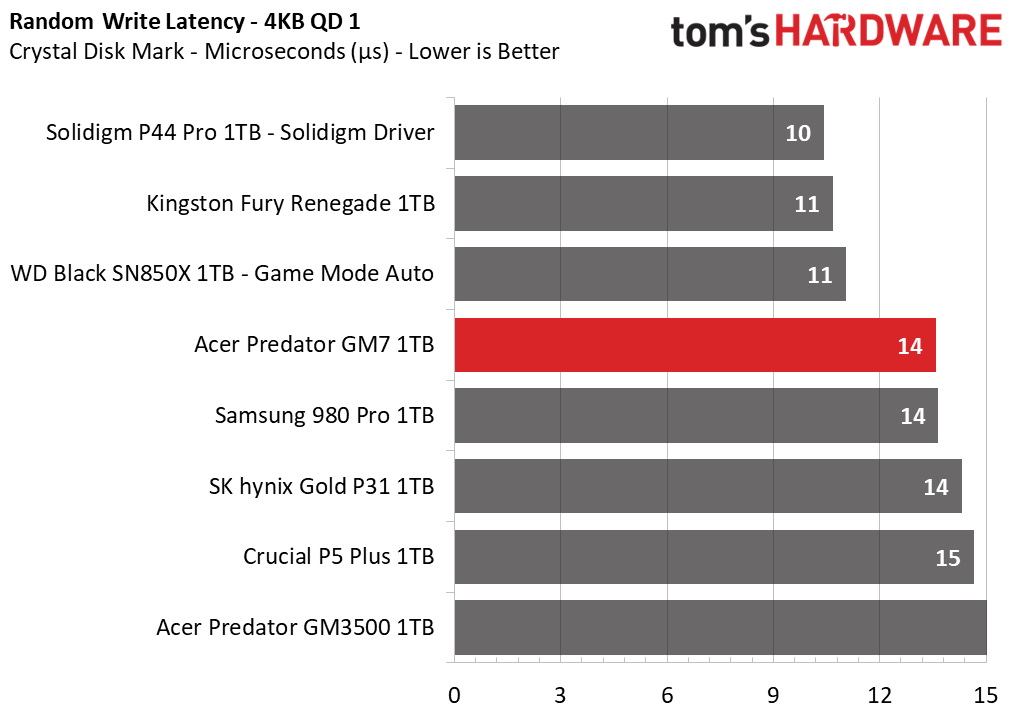


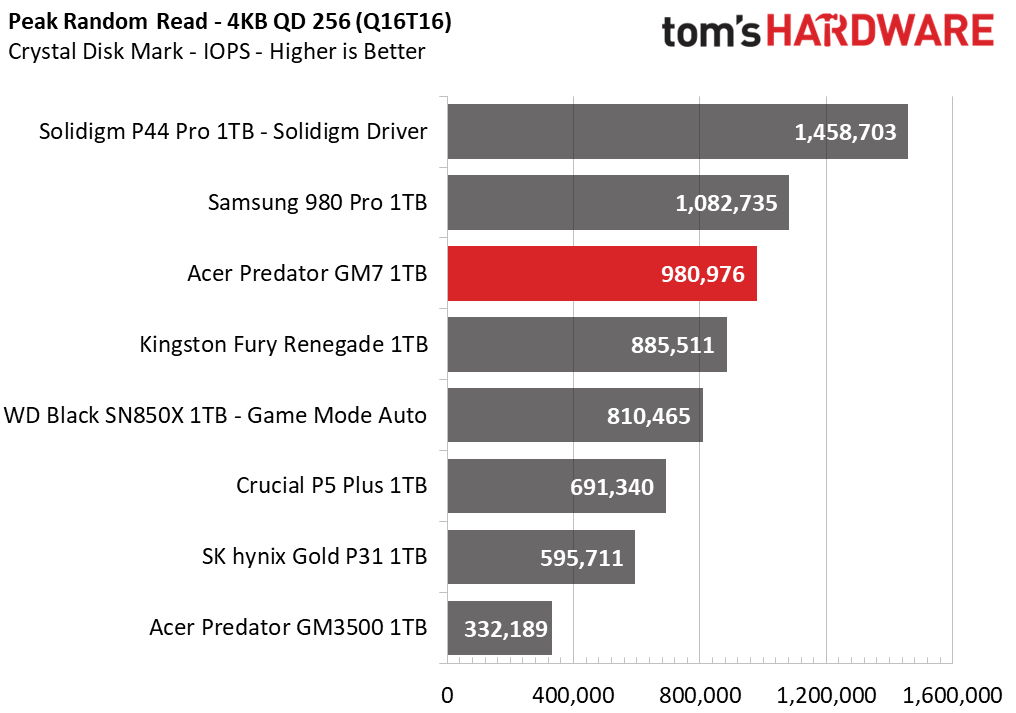
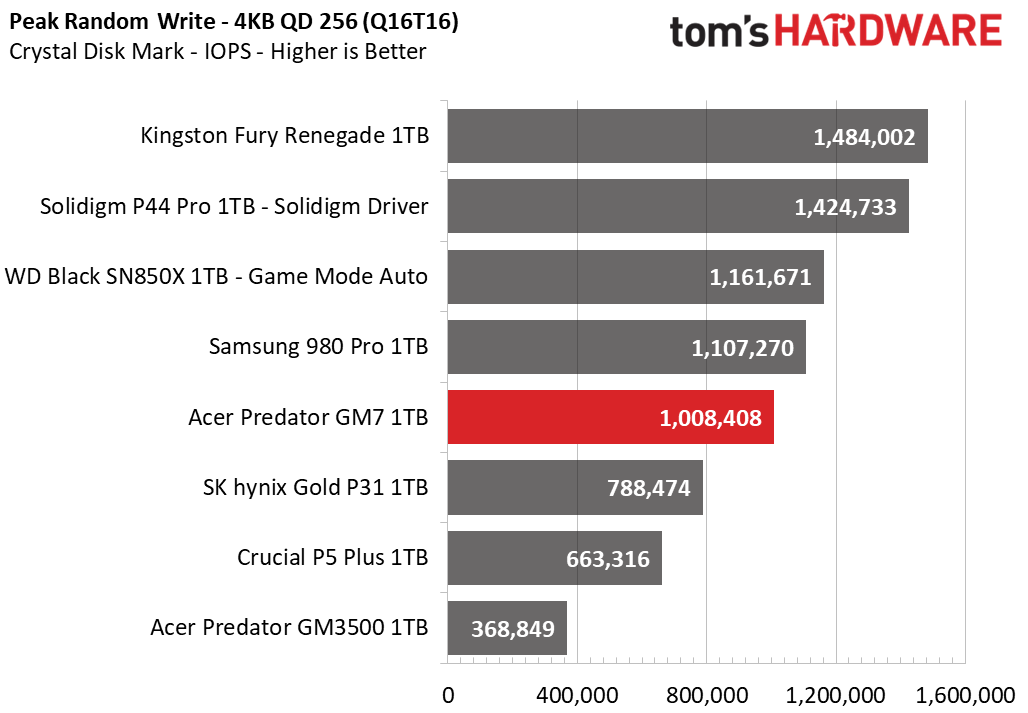


The sequential test results for the Predator GM7 are quite good, but not record-breaking. The drive’s bus and interface speeds continue to help. This is reflected in the sequential CrystalDiskMark results, where the drive does quite well. This isn’t quite bleeding-edge performance, but you can get close to that with some cost and power savings. Performance in random workloads isn’t quite as good, although the flash may be a factor here. An upgrade to YMTC’s 232-Layer TLC would likely help a significant amount.
Sustained Write Performance and Cache Recovery
Official write specifications are only part of the performance picture. Most SSDs implement a write cache, which is a fast area of (usually) pseudo-SLC programmed flash that absorbs incoming data. Sustained write speeds can suffer tremendously once the workload spills outside of the cache and into the "native" TLC or QLC flash.
We use Iometer to hammer the SSD with sequential writes for 15 minutes to measure both the size of the write cache and performance after the cache is saturated. We also monitor cache recovery via multiple idle rounds.

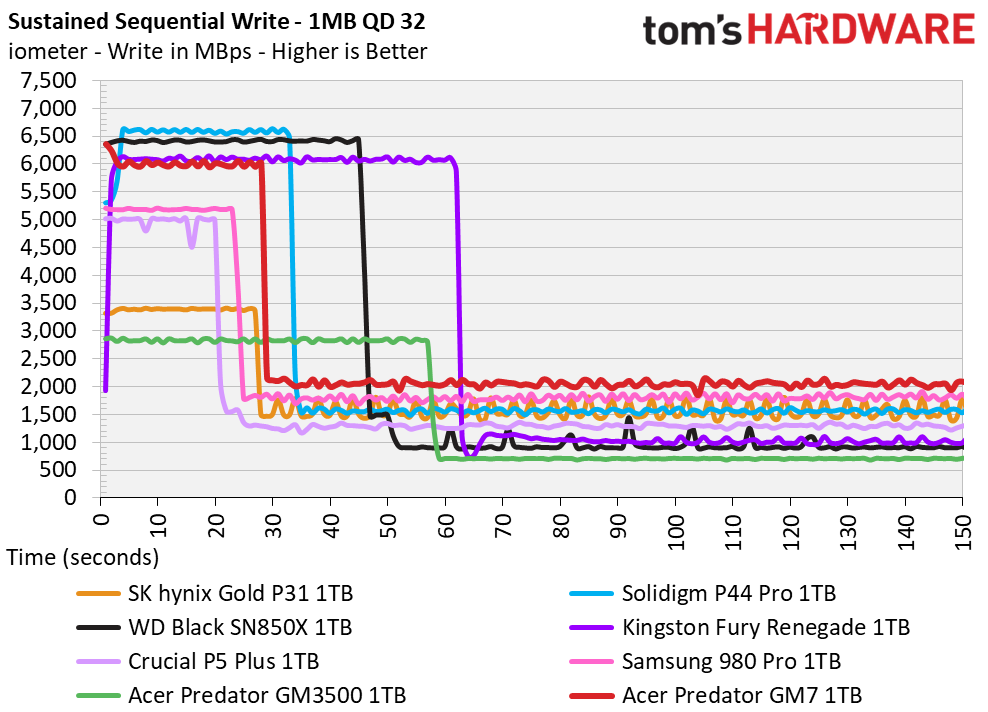



The 1TB Predator GM7 exhibits three primary performance states during sustained write workloads: pSLC, TLC, and folding. It writes at about 6GBps for 28 seconds in pSLC for a cache of almost 170GB. This is not as fast as other drives, and the cache is on the small side, but it does well enough. TLC mode writes at nearly 2.07GBps, which is quite fast and in the vicinity of flash on other four-channel PCIe 4.0 drives like the Team Group MP44L. Folding writes at 770MBps, which, while not amazing, is also not terrible. Cache recovery appears rapid but falls back to TLC speeds in short order.
Power Consumption and Temperature
We use the Quarch HD Programmable Power Module to gain a deeper understanding of power characteristics. Idle power consumption is an important aspect to consider, especially if you're looking for a laptop upgrade as even the best ultrabooks can have mediocre storage.
Some SSDs can consume watts of power at idle while better-suited ones sip just milliwatts. Average workload power consumption and max consumption are two other aspects of power consumption, but performance-per-watt is more important. A drive might consume more power during any given workload, but accomplishing a task faster allows the drive to drop into an idle state more quickly, ultimately saving energy.
Temperatures are gauged at both idle and load states via sensor and an infrared thermometer. The typical ambient temperature is at 24C. The load state involves sustained writes at maximum speed with measurement ensuing if and until throttling is demonstrated to discover the equilibrium temperature.
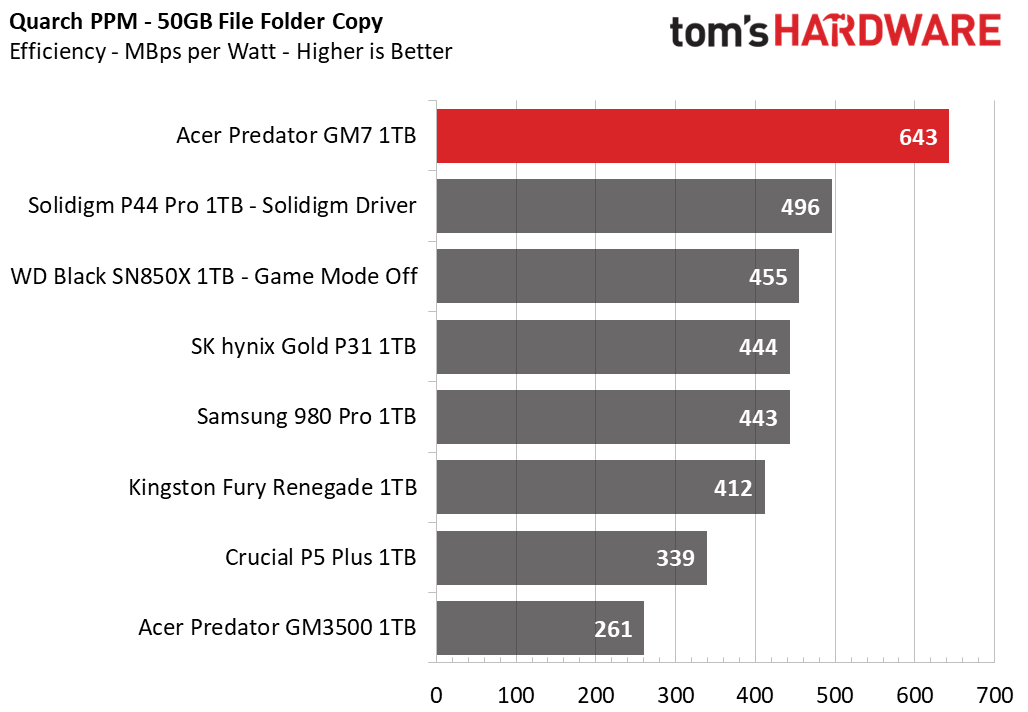
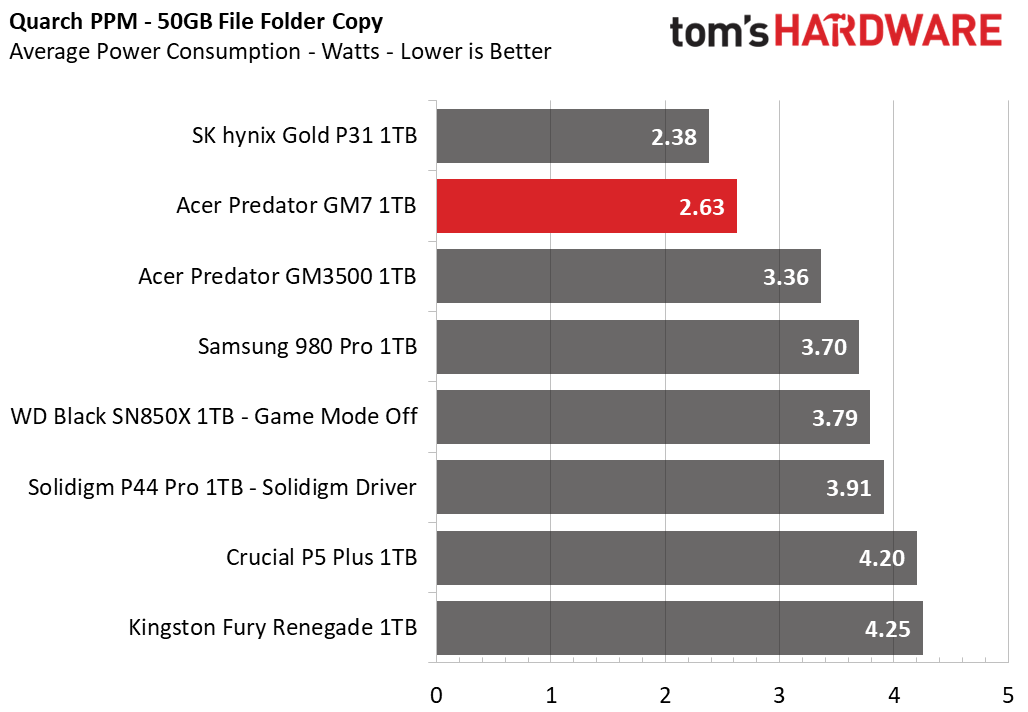

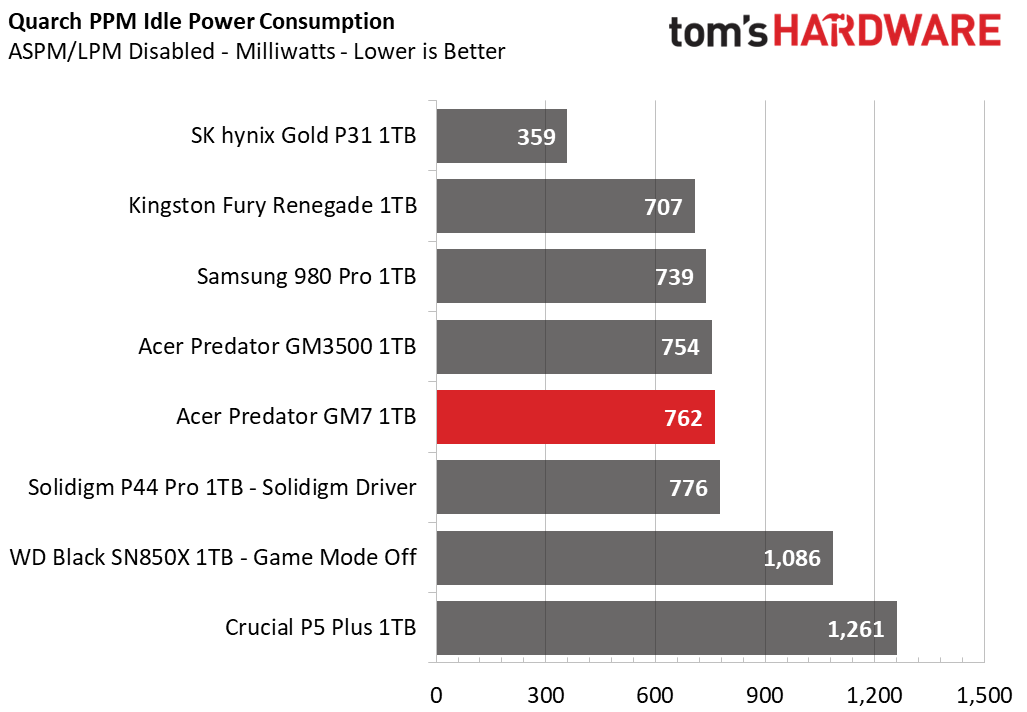
Power efficiency is where the Predator GM7 shines: It is by far the most efficient SSD we have tested. This is expected as the controller is four-channel and DRAM-less and is paired with YMTC’s Xtacking flash technology. It’s more efficient than other four-channel, DRAM-less PCIe 4.0 drives we’ve tested because the faster bus allows full use of the interface to transfer files quickly. We anticipated this in previous reviews and pointed out that the TenaFe TC2201 may have similar results. However, better things are to come from newer flash and, eventually, “low-end” PCIe 5.0 controllers.
Acer markets this drive as having thermal throttling and power management for efficient heat dissipation and better laptop battery life. It’s also great for the PlayStation 5. The drive is set to throttle at a relatively high 90C initially, and with its small cache, it won’t get there with a normal ambient temperature. Our GM7 idled at 43C for the controller via infrared but never throttled even with a full drive’s worth of writes, reaching only 73C. It may benefit from a heatsink in certain environments for very specific applications.
Test Bench and Testing Notes
| CPU | Intel Core i9-12900K |
| Motherboard | Asus ROG Maximus Z690 Formula |
| Memory | 2x16GB Corsair Dominator DDR5 5600 CL36 |
| Graphics | Intel Iris Xe UHD Graphics 770 |
| CPU Cooling | Arctic Liquid Freezer II - 420 |
| Case | Streacom BC1 Open Benchtable |
| Power Supply | Corsair SF750 Platinum |
| OS Storage | Sabrent Rocket 4 Plus 2TB |
| Operating System | Windows 11 Pro |
We use an Alder Lake platform with most background applications such as indexing, windows updates, and anti-virus disabled in the OS to reduce run-to-run variability. Each SSD is prefilled to 50% capacity and tested as a secondary device. Unless noted, we use active cooling for all SSDs.
Conclusion
The Acer Predator GM7 is the most efficient SSD we have ever tested, and it's no slouch with regard to performance. It's good to great in most benchmarks, and performance in sustained workloads is also reasonably good. The great power efficiency helps keep the drive cool, and the single-sided design makes this a great choice for laptops and the PS5. We already liked mid-range PCIe 4.0 drives with four-channel, DRAM-less, 12nm controllers as some of the best values on the market, but pushing the bus further makes the GM7 an even more impressive specimen.
Not everything is perfect, however, as pricing will require threading a needle. The GM7 and similar drives have to cost less than the highest-end drives and cannot cost much more than mid-range PCIe 4.0 alternatives. Sequential performance is not everything, so the choice of flash is also a consideration. The revised 128-Layer YMTC TLC on this drive performed well, but it could be better in some areas — such as random workloads — if Biwin upgrades the drive to 232-Layer flash. Competition is also coming in the form of SSDs outfitted with the TenaFe TC2201 controller and Micron's 232-Layer flash.
This drive is otherwise fairly easy to recommend, if you can find it. Availability is always a concern, which is complicated by the fact that the flashmaker has come under restrictions from the US government. However, we're told those restrictions won't impact this 128-Layer version of the drive, and the impact on possible future 232-Layer variants isn't quite clear yet.
Acer's warranty is solid, but you may want more substantial software support as you would have with, for example, WD's drives. However, if you're looking for a budget-leaning drive that gets you high-end-like performance with great efficiency, it's hard not to suggest the Predator GM7. It demonstrates good things to come for the SSD market and may also be a YMTC harbinger.
MORE: Best SSDs
MORE: Best External SSDs and Hard Drives
MORE: How We Test HDDs And SSDs
MORE: All SSD Content

Shane Downing is a Freelance Reviewer for Tom’s Hardware US, covering consumer storage hardware.
-
cfbcfb Biwin has sold some of their drives made for HP/Acer as a seller on Amazon. I bought one of the GM7000 drives last year as a Biwin drive for a pretty good price. Great performer, no problems. Looks like they make memory, drives and other pcie cards like network adapters for HP and Acer.Reply
I also got a Chuwi mini pc (ugh, don't get me started) that came with biwin ram and ssd, so they're replacing kingston and those other low end brands as branded components. -
jpetso You write about this being an excellent choice for laptops in the summary card, and about idle power consumption for ultrabooks in the Power Efficiency, but there isn't any data in this review to prove it. Idle power is only measured with power management disabled, and the only wattage measurements are for 50GB file copies. Neither of those is relevant for regular laptop usage.Reply
Please bring on idle testing with full laptop-grade power management enabled, and wattage consumed with light web surfing loads.